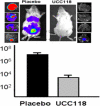Bacteriocin production: a probiotic trait?
- PMID: 22038602
- PMCID: PMC3255625
- DOI: 10.1128/AEM.05576-11
Bacteriocin production: a probiotic trait?
Abstract
Bacteriocins are an abundant and diverse group of ribosomally synthesized antimicrobial peptides produced by bacteria and archaea. Traditionally, bacteriocin production has been considered an important trait in the selection of probiotic strains, but until recently, few studies have definitively demonstrated the impact of bacteriocin production on the ability of a strain to compete within complex microbial communities and/or positively influence the health of the host. Although research in this area is still in its infancy, there is intriguing evidence to suggest that bacteriocins may function in a number of ways within the gastrointestinal tract. Bacteriocins may facilitate the introduction of a producer into an established niche, directly inhibit the invasion of competing strains or pathogens, or modulate the composition of the microbiota and influence the host immune system. Here we review the role of bacteriocin production in complex microbial communities and their potential to enhance human health.
Figures


References
-
- Atassi F, Servin AL. 2010. Individual and co-operative roles of lactic acid and hydrogen peroxide in the killing activity of enteric strain Lactobacillus johnsonii NCC933 and vaginal strain Lactobacillus gasseri KS120.1 against enteric, uropathogenic and vaginosis-associated pathogens. FEMS Microbiol. Lett. 304:29–38 - PubMed
-
- Bhardwaj A, et al. 2010. Safety assessment and evaluation of probiotic potential of bacteriocinogenic Enterococcus faecium KH 24 strain under in vitro and in vivo conditions. Int. J. Food Microbiol. 141:156–164 - PubMed
Publication types
MeSH terms
Substances
LinkOut - more resources
Full Text Sources
Other Literature Sources

